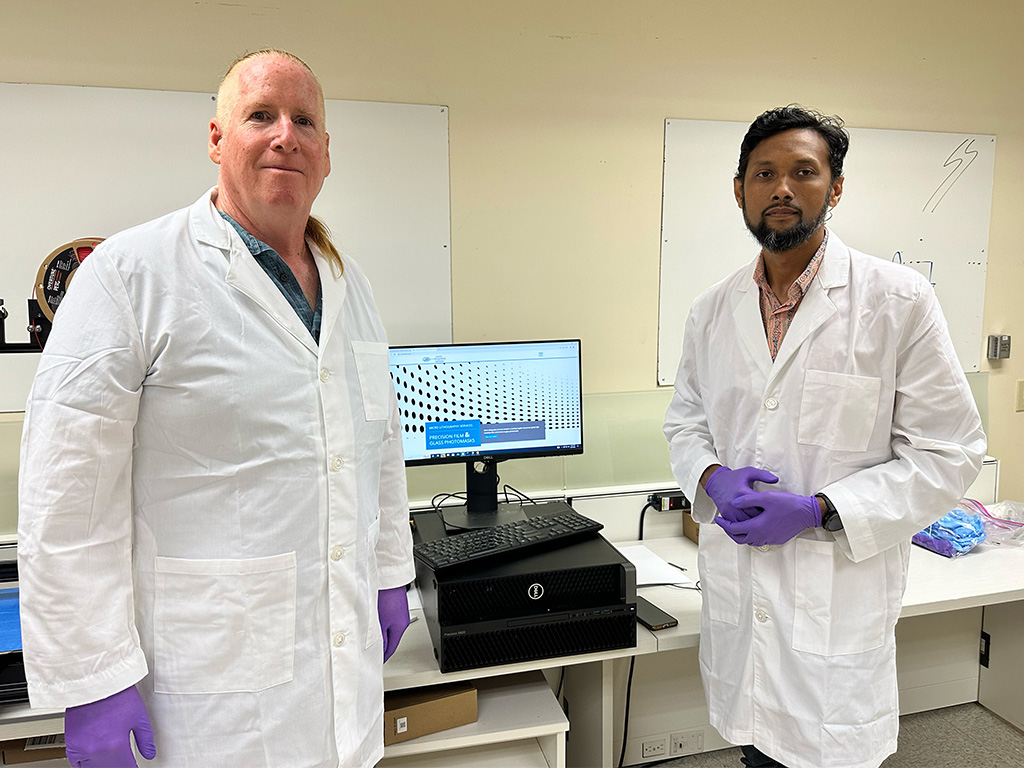
HPU Assistant Professor Arif Rahman (right) with HPU student Greg Ball (left) in an electrical engineering laboratory at HPU.
NASA's Artemis endeavor aims to make history in 2029 by landing the first woman and first person of color on the Moon, marking a phenomenal return to lunar exploration after over 50 years since NASA’s last landing on the Moon. The Artemis endeavor signifies a substantial leap forward in space exploration, enabled by a host of new technology.
However, one persistent challenge NASA faces is lunar dust. Despite sounding mundane, lunar dust poses serious risks to both astronauts and the equipment on the lunar surface. According to NASA, lunar dust is composed of crushed rock, and this fine, abrasive, sharp dust can damage lunar landers, human lungs if inhaled, and interfere with instruments and mechanisms. Lunar dust even causes radiators to overheat and can destroy spacesuits. It also carries solar radiation on the sun-facing side of the Moon, making it cling to everything, compounding its potential risks.
To address this challenge, NASA established the Lunar Surface Innovation Initiative (LSII) in 2019. The LSII aims to stimulate interest and innovation in novel technologies for lunar exploration, with lunar dust being one of the key problems it actively seeks to resolve for the benefit of future generations of space travel.
HPU Assistant Professor of Engineering Arif Rahman, Ph.D., could have the answer that NASA is seeking with his innovative grant proposal to utilize liquid metal to repel lunar dust.
A $50,000 grant was recently awarded to HPU by MUREP Partnership Annual Notification (MPLAN), providing Rahman with the funds to build a LiqMEST (Liquid Metal Electrostatic Protective Textile) fabric at HPU that will actively repel lunar dust on demand, while being flexible and stretchable, ensuring enhanced safety and functionality in lunar environments.
“During my research career, I have worked with liquid metals like gallium alloys, which have the unique capability to be turned on and off, allowing them to appear and disappear based on specific conditions. I am well-acquainted with these dynamic properties,” said Rahman. “So, when I learned that NASA has a problem with lunar dust sticking to the surfaces and posing a significant threat to the equipment and to the astronauts, it occurred to me that liquid metals might offer a potential avenue for developing an electrostatic or electrodynamic shield to mitigate these issues with lunar dust.”
The LiqMEST technology used in the grant proposes that it will utilize electrostatic forces to repel lunar dust, serving as an outer layer for NASA's spacesuits.
“The technology is designed to be stretchable, and when activated, it generates an electric field that repels lunar dust, preventing the dust from adhering to the LiqMEST fabric. This strategy can be applied both to spacesuits and fabric covers for lunar equipment during moon missions,” said Rahman.
The HPU team working on the grant includes Rahman and engineering students. HPU engineering student Greg Ball was chosen first by Rahman to work on the grant with the goal to produce a prototype by the end of May 2024.
“When I read the opportunity to work with Professor Rahman I knew that I had to do this,” Ball said. “I knew I could not pass this opportunity up to work on this grant. I expect to graduate with my engineering degree in 2025, and it will be my second degree at HPU. The University is very supportive, from the professors and staff, everyone at HPU is flexible and the education provided is excellent.”
Once Rahman successfully creates a prototype next year, he plans to submit a full grant proposal to NASA to create a LiqMEST product for NASA for the development of a LiqMEST product for space use. This technology, developed in the labs and classrooms of HPU, has potential applications in future NASA missions exploring extraterrestrial landscapes.
To learn more about the electrical engineering program at HPU, click here.


